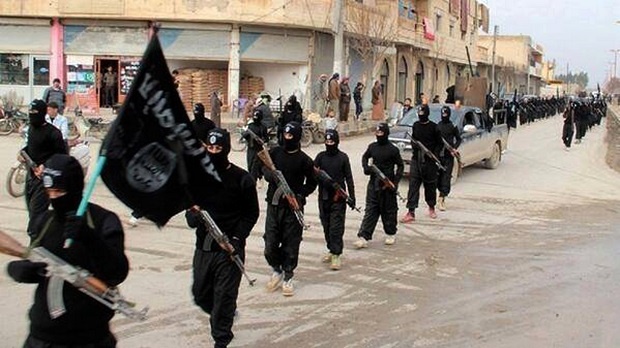Limelight-hungry ISIS ups the ante with violence

This undated file image posted on a militant website on Tuesday, Jan. 14, 2014 shows fighters from the al-Qaida linked Islamic State of Iraq and the Levant (ISIL) marching in Raqqa, Syria. Inspired by the uprisings in Tunisia and Egypt, Syria’s uprising began in March 2011 from the southern city of Daraa. It has since evolved into a civil war in which more than 220,000 people have been killed. AP File Photo/militant website
BEIRUT, Lebanon—As the Islamic State of Iraq and Syria (ISIS) jihadist group comes under growing military pressure, its prodigious propaganda output has slowed somewhat but turned increasingly gruesome in a bid to keep in the headlines.
Since it announced a self-styled caliphate across Iraq and Syria last year, ISIS has become notorious for broadcasting its macabre tactics.
The group’s online network has taken advantage of social media’s instant publishing power to circulate footage of mass killings and beheadings.
READ: Video: Islamic State group beheads Japanese journalist
ISIS shot to global infamy in particular last year following the release of a series of English-language videos depicting the grisly executions of several Western hostages.
Article continues after this advertisementIn November, US President Barack Obama referred to the group not as “masterminds” but rather “a bunch of killers with good social media.”
Article continues after this advertisementBut to maintain the media frenzy, ISIS has resorted to increasingly morbid and elaborate methods of killing.
“The reason IS (or ISIS) ups the ante is because they think people will be bored and they need or want to stay relevant,” said Mia Bloom, a professor at Georgia State University.
Some of ISIS’s more grisly ways of killing captives include firing rockets at them or tying them to ancient artefacts that the jihadists then blew up—as happened in the historic Syrian town of Palmyra.
In a recent video from Iraq, it eschewed its usual before-and-after images of beheadings in favor of grisly footage showing the entire execution process.
The group has also claimed spectacular attacks abroad, including the coordinated assault in Paris that left 130 dead and the downing of a Russian airliner that killed all 224 people on board.
READ: Islamic State group claims Paris attacks
“The graphic videos are attracting a personality type, people who want the real life ‘Call of Duty,’ people who have violent pasts and want to reinvent themselves,” Bloom said, referring to a popular video game.
‘Unparallelled’ brutality
Indeed, in one recent video, ISIS child soldiers weave their way through a crumbling fortress to find and kill captives, in a scenario eerily similar to a video game.
The use of children in the propaganda is also a way of upping the stakes in terms of shock value.
“Children went from being observers of violence on the periphery, to actively involved and fully committed in the videos,” Bloom said.
“This is unparallelled.”
ISIS uses this “ultraviolence” to impress its supporters, terrify its opponents and, importantly, to “project IS’s message across the world,” said analyst Charlie Winter.
Winter, who monitors jihadist activity online, said the group’s propaganda juggles images of violence and portrayals of the “caliphate” as an Islamic utopia.
Among ISIS’s online cheerleaders, broadcasts that feature new methods of killing are particularly “high-impact,” he said.
But the threshold to excite supporters and intimidate enemies keeps rising, Winter said.
Whereas mass beheadings or shootings were “a rarity” last year, new incidents no longer spark the same global outcry.
“In the last few months, IS has continued to explore new depths of depravity—killing people by dragging them to death behind SUVs, drowning them, burning them and so on,” Winter told AFP.
“It has mainstreamed mass beheadings such that people are no longer shocked,” he added.
ISIS reduces media ops
The increasingly gruesome nature of ISIS’s propaganda may also reflect the growing military pressure it has faced in Iraq and Syria, and a desire to continue projecting an image of power and relevance even as its output slows.
Analyst Aaron Zelin noted in a post for the International Centre for the Study of Radicalisation and Political Violence that ISIS’s output has dropped off in recent months, as it has suffered several military losses.
Its media output this year peaked in the summer months, as the group scored victories in Syria’s Palmyra and the western Iraqi city of Ramadi.
Output related to Syria peaked at 3,762 releases during the three-month period between June and August, but it fell to 2,750 releases in September-November, as Russia joined the fray with air raids in support of the Damascus government, he said.
Zelin said the drop could also be tied to the deaths of several prominent IS media operatives, including Junaid Hussain and Mohammed Emwazi, who were killed in US-led coalition air strikes in August and November respectively.
Hussain was a high-profile ISIS figure on Twitter, while Emwazi—known as “Jihadi John”—was the executioner who featured prominently in the group’s videos of Western hostages.
But the drop-off also coincided with several setbacks for the group, which lost the Sunni Arab town of Baiji and the nearby refinery to Iraqi government forces in October.
The following month, Iraqi Kurdish forces backed by coalition strikes retook Sinjar, northwest of Baghdad, as anti-ISIS groups in northeast Syria dealt the jihadists a simultaneous defeat.
RELATED STORIES
Malaysians, Singaporeans nabbed before leaving for Syria had no prior terror links